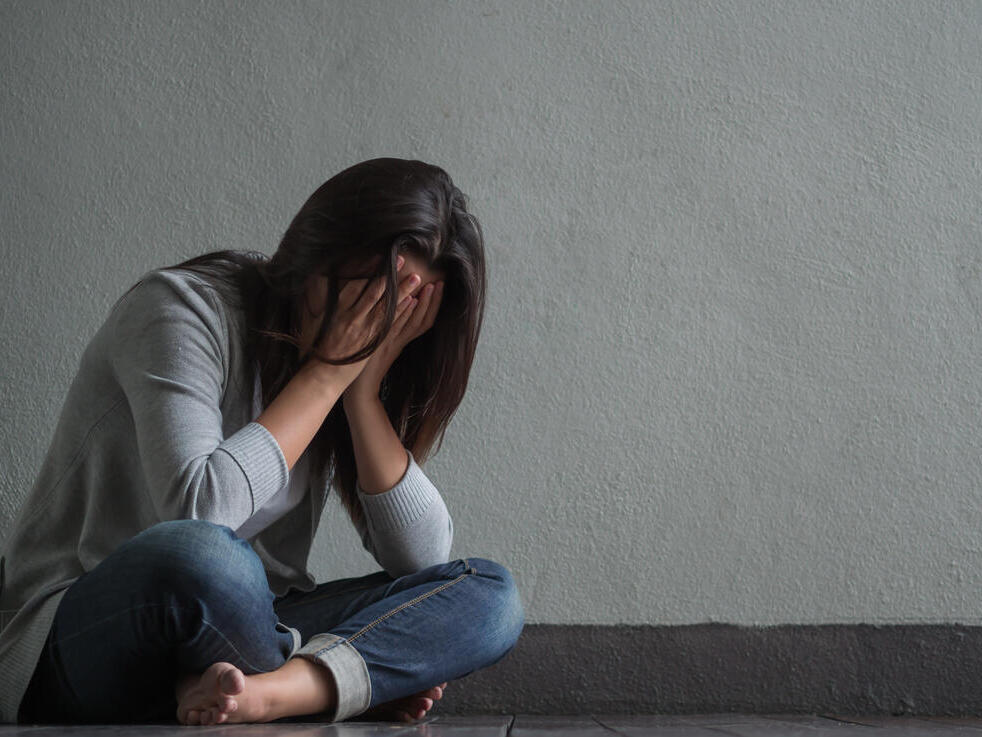Getting your Trinity Audio player ready...
The untimely death of former Israeli model Karin Bauman after a years-long battle with anorexia has rattled many, revealing the peril and suffering experienced by those suffering with anorexia and eating disorders. Understanding their mindset is challenging, as it contradicts our fundamental instinct to eat, making it hard to grasp their inner struggles.
"Why do they do it to themselves?"
The self-destructive behavior of beloved adolescents is distressing to those around them, and comprehending their motivations can be immensely challenging.
4 View gallery


Anorexia contradicts our fundamental instinct to eat, making it hard to grasp a sufferer's inner struggles
(Photo: Shutterstock)
Despite recognizing the harmful nature of eating disorders, individuals who experience them often view them as a solution rather than the root cause of their distress.
Their intense focus on food, weight, and body outweighs the need to address deep emotional pain. It becomes a coping mechanism that is incredibly difficult to relinquish or substitute, even when the long-term consequences are understood.
Isn't it just a matter of wanting to be thin and taking it too far?
Not necessarily. Eating disorders frequently emerge as a reflection or coping mechanism for profound emotional distress or difficult life circumstances.
They can be linked to the anguish that arises from intricate social contexts, including feelings of isolation, rejection, exclusion, low self-esteem, a sense of detachment, intricate interpersonal connections, family dynamics and various other factors.
In some instances, eating disorders may be linked to emotional distress triggered by trauma or significant life experiences. This psychological anguish can arise from the challenges of adolescence, separation, shaping one's identity, navigating the complexities of sexuality and gender, or grappling with self-image and body perception.
It can also be connected to the torment of feeling inadequate, a lack of control in life, and intense internalized negative emotions encompassing worthlessness, hopelessness, low self-esteem, depression, grief and beyond.
If we're talking about mental anguish, why would it result in eating disorders?
Pinpointing the exact reason why emotional pain translates into an eating disorder for one person and not another remains challenging.
Recent research suggests that genetic, neurological, personality and environmental factors may be associated with the onset of an eating disorder, although much of it remains concealed at this stage.
However, it is undeniable that the culture we live in perpetuates a glorification of thinness, with constant exposure to women, girls and, increasingly, boys and men who are engaged in various diets and dissatisfied with their bodies.
The growing preoccupation with body appearance can be a risk factor for the emergence of eating disorder symptoms.
4 View gallery


Former model Karin Bauman died at the age of 35, after fighting anorexia for over a decade
(Photo: Yuval Hen)
How does an eating disorder manifest among youth?
There is a wide range of eating disorders, such as anorexia, bulimia and binge eating disorder, each with its own nuances. However, they all share common features, including disruptions in eating patterns, problematic behaviors related to food, and often distorted self-image and body perception.
Adolescents who suffer from these disorders often experience difficulties in various aspects of their lives, particularly in social interactions, as the disorder can consume their thoughts and lead to isolation and feelings of loneliness.
In some cases, there is a misleading facade where a high-achieving girl excels academically and presents a successful image, causing those around her to overlook her inner turmoil.
Tragically, her apparent "excellence" may actually contribute to her ability to excel in the eating disorder as well. This dichotomy can lead to a rapid deterioration into perilous territories, posing significant risks to her well-being.
Can children experience eating disorders?
There is a distinction to be made between eating disorders that involve body image disturbance and those that do not. The "classic" eating disorders like anorexia and bulimia often emerge during adolescence or early adulthood.
It appears that the changes occurring in the body during this developmental stage, coupled with the first encounters with sexual development and other challenges of adolescence, may direct focus toward the changing body, making it the central arena of concern.
Why is it important to recognize symptoms early?
It is paramount to identify and treat eating disorders early, as it significantly increases the chances of recovery.
On the other hand, an untreated and prolonged eating disorder can be extremely challenging to treat, becoming chronic, leading to severe and long-term physical harm, causing immense suffering and pain and, in about 17% of cases, it can prove fatal.
Is it mostly boys or girls who suffer from eating disorders?
The majority of individuals suffering from eating disorders are girls and women. However, in recent years, the number of boys and men experiencing eating disorders has unfortunately been on the rise.
However, due to less awareness in society and the perception that it may only be a desire for an athletic body, it is more challenging to identify it early among boys.
How do the parents fit in?
The involvement of parents is of utmost importance in recognizing the issue, particularly considering that girls may be reluctant to acknowledge the problem. Moreover, parents and close family members have the potential to play a central role in the treatment journey and act as catalysts for change.
At times, addressing and reshaping family dynamics becomes necessary, particularly when the girl becomes a symbol of distress for the entire family. When parents or the family actively participate in the process, it frequently leads to significant improvements in the girl's condition.
Recognizing an eating disorder
There are several warning signs to eating disorders that could help you zero in on it early:
First warning sign: Eating patterns. These include a change in eating patterns, such as reduction in food intake, rigid adherence to specific eating schedules, skipping meals, strict rules and regulations regarding eating, unusual eating behaviors like cutting food into extremely small pieces or very slow eating.
Other patterns include avoidance of shared meals, restriction of certain food groups (e.g., complete avoidance of sugars/carbohydrates/fats), predominantly consuming only one type of food (e.g., primarily proteins), episodes of binge eating or disappearance of large quantities of food from the house, secretive eating, and so on.
Second warning sign: Physical aspect. These include a sudden change in body appearance, severe weight loss, fluctuation in weight, swelling in the cheeks, swelling in the salivary glands, hair loss, growth of fine hair on the body (lanugo). Other signs include reports of frequent throat pain, toothaches, cracked fingernails, dry skin and wounds.
This can also include excessive fatigue, weakness, dizziness, slow heartbeat. There may also be complaints of digestive difficulties such as constipation or diarrhea, and abdominal pain. There can also be hormonal changes such as cessation of menstruation or delayed sexual development and growth.
Third warning sign: Behavioral and cognitive aspect. This can include an increased preoccupation with food, excessive thinking about food or calories, talking about food, extensive planning around food and grocery shopping, preparing food for others, serving food to others and spending a lot of time in the kitchen.
You might also see someone give up enjoyable activities for fear that food will be present (such as social gatherings and the like), and frequent weighing.
Other signs could be engaging in sports excessively, such as engaging in physical activity even when feeling unwell or when conditions are unfavorable, difficulty in giving up physical activity, engaging in high-frequency intense sports, and attempting to "build a body" at any cost. There is also the practice of immediately going to the bathroom after eating, or testimonies of laxative use or vomiting.
There may also be attempts to hide the body, difficulty wearing a swimsuit, wearing loose and baggy clothing, sometimes even difficulty showering or being near mirrors.
I've recognized some disconcerting signs. Now what?
First and foremost, it is important to note that these warning signs primarily focus on visible behaviors and patterns, thus they do not provide insights into the individual's psychological and emotional state or their inner thoughts.
It is common for those grappling with eating disorders to unconsciously perceive them as coping mechanisms for distress, rather than recognizing them as distress signals. Consequently, individuals, particularly girls, may resort to falsehoods or denial about their condition and their need for assistance.
This response is often driven by the fear that seeking help could jeopardize the temporary relief they derive from the disorder.
It's a safe bet you're heard that the road to hell is paved with good intentions. While you might be eager to help, it's important to avoid taking certain actions.
Avoid unnecessary probing. Questions such as "Why are you doing this to yourself?" or "When will you stop?" may indeed be curious, but they do not contribute to healing. They may only evoke feelings of guilt.
Instead, focus on her well-being and offer a listening ear if she wishes to share. Sometimes, there is a tendency in the surrounding environment to seek "blame," which is not always effective and can lead to distancing and freezing.
Despite the difficulties, it is important at this stage to set aside the search for blame and focus on the healing process.
Refrain from making comments about eating or weight. Even well-intentioned positive remarks like "You look great now that you've gained weight" can be destructive.
It's best to avoid commenting on eating and appearance, even if you see improvement or have concerns about deterioration. If the individual is already under the care of professionals, it's better to consult with them.
Questions like "Did you eat everything on the menu?" can also lead to undesired outcomes, so unless you have explicit guidance from a nutritionist, it's best not to approach the subject in that way.
Sometimes the individual may initiate a conversation about their menu, such as expressing a desire to eat something not on the menu, switching things around, or trying a food they considered "forbidden." Be non-judgmental and listen to what they have to say – sometimes it can indicate progress.
Some girls may feel more comfortable eating with others as part of their recovery. If this is the case, you can suggest the idea of eating together, perhaps even assisting in meal preparation.
However, for certain individuals, eating in social settings, such as large family meals, can pose challenges. In such situations, it's helpful to find strategies to alleviate the difficulties, such as eating beforehand and being present at the table without consuming food.
Additionally, it is crucial to ensure that no one she comes in contact with makes comments about her eating habits.
Equally important is taking care of yourself and maintaining your own strength. Supporting someone close to you who is struggling with an eating disorder can also affect your own mental well-being, and the recovery process can be arduous and lengthy.
Remember, to effectively aid their recovery, it is necessary to cultivate your own resilience as well.



